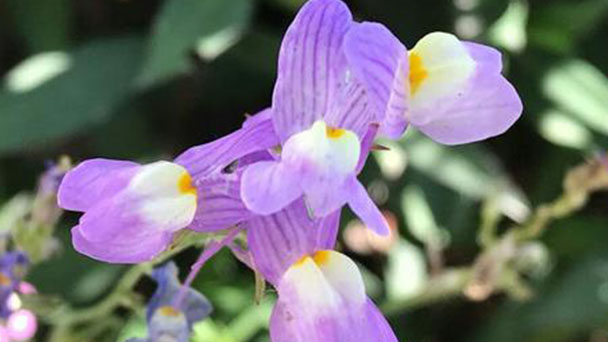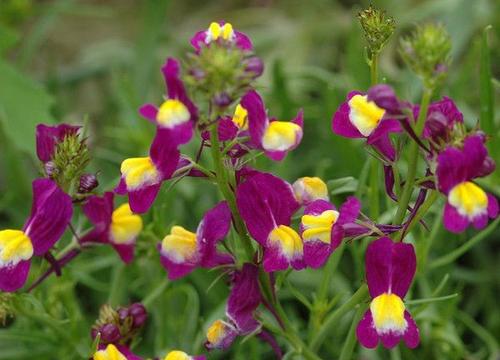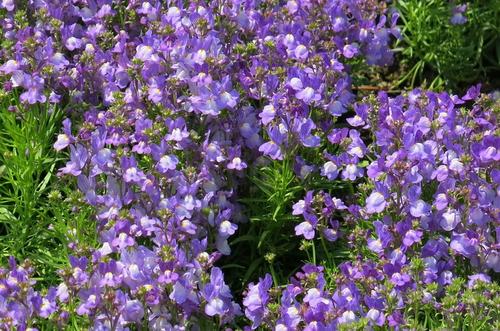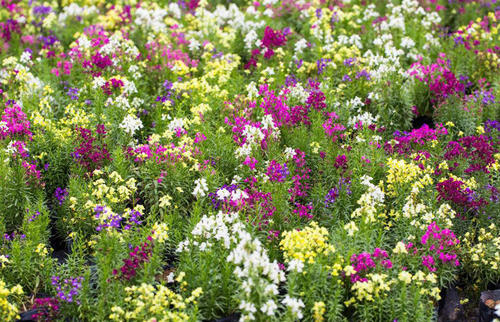Yellow toadflax (Linaria vulgaris) profile
Written by Maggie
Mar 03 2021

Yellow Toadflax (Linaria vulgaris), also called butter and eggs, is a perennial flower of the genus of Yellow Toadflax and the family of Radix Sophora. Yellow Toadflax is native to the northern temperate zone of Eurasia and grows on sandy land, hillside grassland and roadside. Yellow Toadflax height is 30 ~ 80cm. Stem is cylindrical, grayish green, glabrous, grayish white in the cross section. Leaves of Yellow Toadflax are much crinkled and easily broken. Leaves are lanceolate to lanceolate, 3 -- 8cm long, entirely. Leaf veins are pinnate, glabrous. Racemes of Yellow Toadflax are terminal, florets dense, about 2cm long, yellow, summer flowering, capsule ovoid.
Yellow toadflax picture

Morphological characteristics of Yellow toadflax
Stems
Yellow Toadflax is a perennial plant, 20 -- 80 cm tall, glabrous stems and leaves. Stem is erect, often distally branched.
Leaf
Leaves of Yellow toadflax are usually numerous but alternate, less lower whorls, upper alternate, less all in 4 whorls, bar, often univeined, less than 3 veins, 2 -- 6 cm long, 2 -- 4(10) mm wide.
Flowers
The racemes of Yellow Toadflax are short and dense, and the fruits are elongated and scattered. The racemes and pedicels are glabrous or with a few short glandular hairs. Bracts are oblate to narrowly lanceolate, beyond pedicel; Pedicels are 2 -- 8 mm long; Calyx lobes of Yellow Toadflax are lanceolate, ca. 4 mm long, 1-1.5 mm wide, glabrous outside, more or less glandular hairy inside; Corolla is yellow, 10-15 mm long except spur, upper lip longer than lower lip, lobes 2 mm long, ovate, lateral lobes of lower lip ovoid, 3-4 mm wide, middle lobes liguulate, spur slightly curved, 10-15 mm long.
Fruit
Capsule of Yellow Toadflax ovoid, ca. 8 mm. Seeds are discoid, margin has broad wing, mature often central nodular protuberance.
Ecological habits of yellow toadflax
Yellow Toadflax grows on sandy land, hillside grass and roadside.
Yellow Toadflax is light-loving, tolerant to cold and heat. It is suitable for moderately fertile, moderately wet and well drained soil.
Yellow Toadflax is usually grown for one or two years in gardens in northern China. Raceme, colorful, pale yellow, pink, calyx five lobed, corolla long tube, about 3-4 cm long capsule globose, round seeds.
How to grow and care for yellow toadflax
Humidity
The relative humidity of air must be maintained at 75 ~ 85% after cutting. You can spray cuttings to increase the humidity, 1 ~ 3 times a day, the higher the temperature on sunny days, the more times the spray, the lower the temperature on cloudy and rainy days, the fewer or no spray. But if sprayed too much, the cuttings are susceptible to disease and rot, because many kinds of disease are present in water.
Light
Cuttage propagation cannot be separated from sunlight irradiation, but the stronger the illumination, the higher the temperature inside the cuttings, the more vigorous transpiration of the cuttings, the more water consumed, which is not conducive to the survival of the cuttings. Therefore, after cutting, you must block out 50 ~ 80% of the sun, to root grow out, and then gradually remove the shading net: sunny day at 4:00 PM in addition to the shading net, the next day before 9:00 am covered with the shading net.
Trim
In the process of flowering, cutting off three leaves of the remnant flower band, can prolong the flowering period of Yellow Toadflax.
Moisture care
Yellow Toadflax likes the drier air environment, overcast and rainy days are too long, easy to be infected by germs. Avoid rain and keep the leaves dry at night.The optimum air relative humidity is 40 ~ 60%.
Temperature care
Yellow Toadflax likes cold climates, avoiding heat, frost resistance. The winter temperature requirements are not very strict, as long as not subjected to frost can be safe
In the winter; In late spring and early summer, the temperature is as high as 30℃ above death, the most suitable growth temperature is 15 ~ 25℃. Try to plant seeds in autumn and winter to avoid high summer temperatures.

Light care
In late autumn, winter, early spring three seasons, because the temperature is not very high, it is necessary to give direct sunlight, in order to facilitate its photosynthesis and the formation of flower buds, flowering, fruiting. In summer, if Yellow Toadflax encounters hot weather, it needs to be shaded from the sun by about 50%.Indoor conservation and appreciation are put in after flowering, want to be put in southeast near the door window, in order to extend flowering period and increase flowering amount as far as possible.
Water care
With other brews, water demand is more, but the most afraid of chaos fertilization, concentrated fertilizer and n, p, k, required to follow the "light weight more frequently, and less time and complete nutrition" and "room of dry wet, dry to dry, not stem not watering, watering is drenched the" principles of two fertilization (water), and after fertilization, the evening want to keep dry leaf and flower:
Fall care
Seedling on the pot after a period of time to recover, the fertilizer and water management to quickly catch up. Water management in accordance with the "flower", "flower" - water - "flower", "flower", the order of the water cycle, interval of about 1 ~ 3 days,
Winter care
Although Yellow Toadflax still continues to grow, the lower temperature will slow its growth rate, and it does not require much fertilizer and water, or even control fertilizer and water.
Spring care
After the temperature rises, the Yellow Toadflax growth recovers rapidly, and gradually enters the stage of flower bud differentiation and flowering, which requires a lot of fertilizer and water.
Disease control of yellow toadflax
Yellow Toadflax has good disease resistance and generally has no serious disease. In terms of insect pests, attention should be paid to the control of poplar flies and thrips.
The distribution of yellow toadflax
Yellow Toadflax is native to the northern temperate zone of Eurasia.
Yellow Toadflax is commonly found in Northeast China, North China and Shandong, Henan, Jiangsu (northern), Shaanxi and Gansu (northeastern) provinces.

Latest Updated
- Benefits of Bugleweed - 7 Science-backed Health Benefits
- Bugleweed Dangers & Side Effects - Is It Poisonous?
- How to Plant Evergreen Trees - What You Should Know
- When to Plant Evergreens - Grow Guide for Evergreen Trees
- 12 Wonderful Evergreen Shrubs for Your Garden
- 12 Popular Evergreen Plants with Pictures for Beginners
- When And How To Prune A Lilac Bush Like a Pro
- How to Grow & Care for Lilac Vine (Hardenbergia Violacea)
- Japanese Lilac Tree (Syringa Reticulata) Care & Propagation Guide
- Shumard Oak Pros and Cons - What to Know
Popular Articles
- Winter maintenance of Antirrhinum Majus
- How to Grow Terminalia Mantaly Tree
- How to Grow and Care for Crossostephium Chinense
- How to grow Antirrhinum Majus in spring
- Peristeria Elata (Dove Orchid) Profile: Info & Care Guide
- Underwatered Snake Plant (Sansevieria Trifasciata) - Signs And How To Fix
- How to Care for Brazilian Jasmine Plant (Mandevilla Sanderi)
- How to Grow & Care for Graptopetalum Purple Delight in Summer
- Rosa Chinensis (China Rose): Plant Growing & Care Tips
- How to Care for Baby Sun Rose (Aptenia Cordifolia)